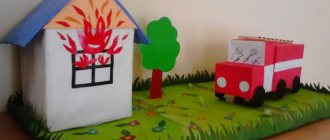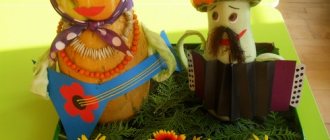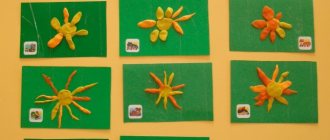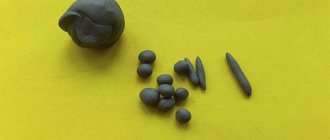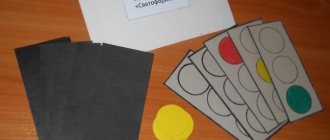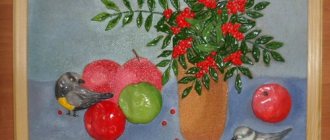Summary of GCD: Modeling Topic: “Rowan autumn leaf”
| Direction: Artistic and aesthetic development Educational area: Artistic creativity middle preschool age (4-5 years) Compiled by: teacher G.G. Kurbanyazova Program tasks: 1. Strengthen the ability to separate a piece of plasticine from a whole piece by pinching off, roll out the plasticine with straight and circular movements between the palms.2. Teach children to place a piece of plasticine on a base (cardboard sheet), press and smear it with the thumb of the right hand, give it the shape of a rowan leaf.3. To develop children’s ability to place parts of a rowan leaf on a cardboard sheet of paper (each other, opposite each other, maintaining the distance between pairs of leaves).4. Cultivate the ability to bring something started to completion, and experience joy from the results of collective work. Integration of areas: Cognition - expand children’s understanding of the seasons, plants growing in the kindergarten area. Reading fiction - introduce them to verbal art, develop artistic perception of poetic works (poems). Communication - develop free communication with adults and peers. Formation of a dictionary : to activate the words in children's speech - coral, rowan - rowan, clusters, flexible branches, autumn, leaf petiole, cinchona. Material: Demonstration: pictures depicting summer and autumn rowan bushes; subject pictures - oak, rowan, poplar, birch leaves; easel, a sheet of whatman paper with a painted rowan tree (without leaves). Handout: plasticine, stacks, backing board, wet napkin, cardboard sheet of rowan tree (according to the number of children). Preliminary work: Observations in nature, excursions, conversations about the season, plants, examination plot paintings, subject pictures, reading children's fiction, memorizing poems, making and guessing riddles about plants, node - modeling, didactic game "Which tree is the leaf from?", "One, 2, 3 - run to the tree." Procedure: Educator : I invite the children to listen to the riddle: In the spring I turned green, In the summer I got tanned, In the autumn I put on Red corals... Children: Rowan B: Well done, they guessed the riddle. And today she came to visit us. Let's ask her to show herself to us. Call me kindly. Rowan... D: ... Rowan, rowan B: Repeat after me: “Show yourself to us, please, rowan!” D: Show yourself to us, please, rowan! (I remove the napkin from the painting on the easel, the children come up and look) Q: Here is the mountain ash. Guys, let's look at the rowan and tell you about it. Is rowan a tree or a bush? What branches, what color are the berries? D: Rowan is a shrub, because it has branches coming straight from the ground, they are thin and flexible, the berries are red. Q: I agree with you guys, the rowan is a very beautiful shrub, especially in the fall. Red clusters hang on rowan branches. Why is she so sad? Who knows? ... (children's answers) Q: Correct! It has no leaves. And why? D: Autumn has come... Q: The season of autumn brings both joy and sadness. Autumn gave the mountain ash a very beautiful colored outfit... (showing pictures). What color were the leaves on the mountain ash in summer and autumn? D: In the summer - green leaves, and in the fall - orange-red, brown leaves... And now the leaves have fallen, and the mountain ash is sad. Q: Guys, let's help the mountain ash. We will make rowan leaves from plasticine. And for this we need to learn as much as possible about rowan leaves (on the table there are pictures depicting birch, oak, poplar and rowan leaves) Q: I suggest finding a rowan leaf (children find and show) Q: Well done, you have correctly found a rowan leaf (examination leaf). What is this? (showing) D: Stem...B: And it’s called correctly - petiole, the leaves live on it. First we will sculpt the petiole. Here’s a petiole (I draw it in the air with my finger, the children repeat). And the leaves, look, one is up (I show it in the air, the children repeat). Then there are two identical brothers (children point with their palms). Below are the brothers - the leaves, older and longer in size. The lower, the longer the leaves. The brothers live very friendly. Look - there are two twins and they don’t push each other. We need to make the same friendly leaves for the mountain ash so that it does not get upset, but only rejoices. Game: “Rowan” (physical exercises) Goal: to continue to cultivate interest in gaming activities. 1. Rub your palm against your palm (warm up).2. Look at your palms: at the left, and then at the right. 3. Show the leaves - open your palms as much as possible. 4. Stand on your toes, stretch like a mountain ash towards the sun.5. Pull the arms up - the branches grow.6. Circular movements with the palms - the leaves sway in the wind.7. The wind blew - sway your whole body from side to side.8. Spin around - arms to the side (leaf fall).9. The leaves have fallen - sit down. At the end of the physical minute, the children go and sit down at the tables. Q: I suggest taking rowan leaves made from cardboard. We need to decorate them, but not with paints, but with plasticine. I show you how to work with plasticine and how to properly smear colored plasticine on a base. Let's make a branch in the form of a thin rope. Place a piece (flagellum) of plasticine on the base (cardboard sheet) and press down. For the leaf, you need to flatten a small sausage so that it looks like a boat and smear it with the thumb of your right hand. And so we make all the rowan leaves. Children work independently at the tables. Individual reminders as work progresses. When finished, children look at the leaves and analyze. Q: Let's look at their work. Do you think the mountain ash will like them? (the work is being analyzed). Children approach the rowan tree on the easel and attach leaves to the branches. Q: Guys, look at what a beautiful rowan tree, what colorful leaves it has! Q: Well done, you did a very good job today. I suggest you listen to Irina Tokmakova’s poem “Rowan Berry”: Rowan Berry A red berry Or this berry The rowan tree gave me. It’s just not ripe, I thought it was sweet, or a cunning rowan, but it’s like a cinchona. Did you want to make a joke? < Previous Next > |
doshkolnik.ru
Lesson summary for sculpting “Autumn Tree”
Summary of a modeling lesson on the topic: “Autumn tree”
Program content: 1. Teach children to tear off small pieces of plasticine, roll them between their palms, and flatten them with a finger on top, attaching them to a sheet of paper.
2. To consolidate children’s knowledge about the color and size of autumn leaves. 3. Reinforce the concept of “leaf fall”, learn to move around the site, following the instructions given in a playful way; accompany the words of the poem with appropriate movements. 4. Foster independence and accuracy. Material: red, brown, white and yellow plasticine, sheets of paper. Preliminary work: looking at autumn trees, talking about autumn. Vocabulary work: autumn, leaf fall, forest, autumn. Progress of the lesson: - Guys, what time of year is it now? (autumn) -Why do you think so? (it became cold, people put on warm clothes, etc.) -What color are the leaves on the trees? (yellow, red) -Yes, in the fall the leaves on the trees first turn yellow or red, and then begin to fall off, that is, fall to the ground. -What is the name of the phenomenon when leaves fall from trees? -This phenomenon is called leaf fall. The leaves, falling to the ground, swirl merrily in the air. - Let's turn into yellow leaves. The game “Falling Leaves” is played. Progress of the game: All children are given leaves from an autumn bouquet. - Guys! You will all be leaves, choose the leaf you like: some are yellow, some are red, some are big, some are small. Each child shows and names which leaf he chose by color and size. — The leaves are light, they fly slowly through the air. (Children run and wave their arms.) Leaves are falling! Leaf fall! Yellow leaves are flying! It's like umbrellas are circling! — Beautiful yellow leaves are spinning. (The actions are performed by children with yellow leaves.) - Beautiful red leaves are spinning. (Children with red pieces of paper perform the actions.) - They turned around and sat on the ground. (Children crouch.) - Sit down! They sat down and froze. (The children do not move.) - The wind blew: one-two-three, They took off from the ground, (an adult blows, followed by the children.) - And they flew high, But it was far from the sky. -The leaves rose and scattered in different directions. (Children scatter around the playground.) - Spinning, spinning, spinning! (children spin around) - Falling leaves! Leaf fall! — Leaves are flying in the wind (children are running and spinning with leaves in their hands). - We circled again. They sank to the ground to sleep. “The breeze has died down, and the leaves are slowly falling to the ground” (the children slowly crouch down). The game is repeated 2-3 times. Then the children sit at the tables. — Guys, look, are there sheets of paper on the table?
-What does the tree have? (trunk)
- Let's make a barrel, tear off a piece of plasticine and roll it out between our palms, put it on a sheet of paper, press it on top with our fingers.
- What else is missing? (branches)
— We tear off a small piece of plasticine, roll it out between our palms, then apply it to the trunk and press it on top with our finger. - What else does our tree lack? (leaves) - Let’s make plasticine leaves for our tree. - What color should we use plasticine to make the tree look like autumn? (yellow, red, orange) - Look how we will sculpt leaves. — We tear off a small piece of plasticine, roll it out between our palms, then apply it to the branches, pressing it on top with our finger. — The pieces need to be attached to tree branches. I show the children how to tear small pieces from plasticine, roll them between their palms and, pressing on the balls, attach them to tree branches. — The tree became autumn because we made yellow leaves for it. - How can you name many trees in one word? (forest) Let's all say “forest” together. - Yes, we got an autumn forest. - Look, on some trees the leaves are attached to the branches, and on other works - the leaves are spinning in the air and falling to the ground. — What is the name of the phenomenon when leaves fall to the ground? (leaf fall) - Let’s all say “the fox is falling” together. - Yellow leaves dance, fall from the branches, fly, This golden fairy tale is called “leaf fall.” — All the children tried very hard. This is what a beautiful autumn forest we have. - Now let’s take our works to the exhibition of creativity, please our mothers, fathers, grandparents.
Modeling junior group on the theme of autumn, details with photos
According to the methodology, teaching modeling in the younger group of kindergarten (2-3 years old) is subject-oriented. At first, kids are just learning to feel the material, to give a piece of plasticine simple shapes: a disk, a cylinder, a ball, a cube, etc. Children try to sculpt individual objects and figures (also simple at first) when the basics of modeling have been mastered. However, with your help, your child will be happy to cope with simple modeling on autumn themes.
Talk to your child, ask what he imagines when he thinks about autumn. While walking in the park or in the forest, pay your child’s attention to how beautifully the shades of foliage change in autumn, how bright the rowan berries become, how many mushrooms appear at this time of year. Offer to make something “autumn” together. For example, autumn leaves, an autumn tree, a hedgehog, a mushroom.
autumn leaves
What to prepare for sculpting:
- a set of plasticine (red, terracotta, yellow, green);
- a sheet of thick cardboard;
- flexible board for modeling;
- plastic spatula;
- plastic or wooden stack.
Stacks and spatulas for modeling
Sequence of sculpting autumn leaves:
Walking through the autumn park, together with your child we will collect several beautiful, bright leaves of different shades. They will serve as a model for plasticine crafts. It is better to choose simple oval-shaped leaves with a smooth or finely toothed edge. Let's lay them out on the table and ask the kid what colors of plasticine will be needed to make autumn leaves.
Let's make blanks of leaves. Let's ask the child to roll small plasticine balls: dark red, orange, yellow, green. To make the leaves beautiful, for some balls you can mix pieces of plasticine of different colors. For example, red with yellow or terracotta, green with yellow.
We invite the child to carefully flatten the blank balls with his fingers, trying to give them the shape of leaves. Let's correct the result a little: flatten the resulting flat cakes in both directions, slightly sharpen the upper edge.
The next stage of work - drawing veins and teeth on autumn leaves - can be quite difficult for a 2-3 year old child. So let him just watch how we do it. Together with your child, let's look at the veins on the leaves. Using a stack, we will first draw the central vein, and then the side ones.
Using a spatula, cut out the cloves along the edges. We will definitely invite the child to try to design 2-3 leaves on their own.
Lay out the finished plasticine leaves, alternating colors on a sheet of cardboard. It is better to place them with the upper, pointed side towards the outer edge. Lightly pressing with your finger, fasten the leaves together and fix them on the cardboard. Decorate the “picture” with acorns or a sprig of rowan.
hedgehog made of plasticine and seeds (applique)
What to prepare for sculpting:
- a handful of large seeds (sunflower, watermelon);
- plasticine (brown, light gray, black);
- plastic spatula, stack;
- a convenient board for modeling;
- a sheet of white (or other light) cardboard;
- a sheet of light yellow or green cardboard;
- dried or plasticine autumn leaves to decorate the composition.
Sequence of work:
Draw the outline of a hedgehog on white cardboard. You can print the finished template. Cut out the figure along the outer edge of the outline, paste it onto colored cardboard, and dry it. It is important to leave distinct dark outlines to make it easier for the baby to work on the appliqué.
Let's knead and warm up pieces of gray plasticine in our palms. Let's put them on the image of a hedgehog. We invite the baby to flatten them and fill in the contours of the face and tummy. We will also prepare brown plasticine. Let's fill in the contours of the back. To simplify the work, plasticine can be smeared only on the back of the hedgehog, and the muzzle can be left as cardboard and the eyes and nose can be drawn in with paints or felt-tip pens.
Let's make needles from sunflower or watermelon seeds. We immerse the pointed part in brown plasticine on the back of the hedgehog and press it slightly. So we will sequentially fill the entire space with seeds.
Let's ask the child to roll three small balls from black plasticine. Two smaller ones are for the hedgehog’s eyes, one slightly larger one is for the nose. Let's attach them to the muzzle. Let's draw the mouth using a stack. Let's complement the composition with plasticine leaves, apples, mushrooms, etc.
